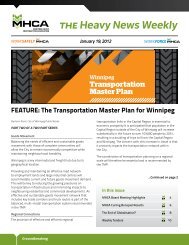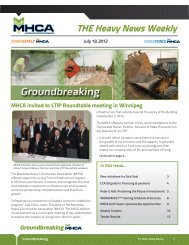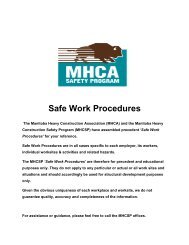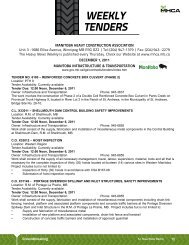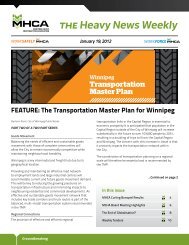2012 Perspectives Magazine - Manitoba Heavy Construction ...
2012 Perspectives Magazine - Manitoba Heavy Construction ...
2012 Perspectives Magazine - Manitoba Heavy Construction ...
Create successful ePaper yourself
Turn your PDF publications into a flip-book with our unique Google optimized e-Paper software.
Much of what is great about <strong>Manitoba</strong> grew from the<br />
creativity of its leading citizens. Moving fresh water<br />
down an aqueduct 100 km away from a thirsty city; building a<br />
park that is a magnet for families who come here from every<br />
corner of the globe; a floodway that has saved billions of dollars<br />
and untold hardships. Our next visionary moment is to see the<br />
North for its limitless potential: commerce, tourism, sustainable<br />
economic development, opportunities for indigenous peoples<br />
and a strategic plan to assure our national sovereignty.<br />
Studying <strong>Manitoba</strong>’s northern<br />
potential is hardly new. Duff<br />
Roblin established The Northern<br />
Transportation Commission in<br />
1967. Many of its recommendations<br />
await implementation. The federal<br />
government’s focus on the North<br />
and identification of 4 pillars of<br />
strategic importance provides a<br />
new opportunity for <strong>Manitoba</strong> to<br />
add a constructive voice to the<br />
national discussion. We are the<br />
only province with an inland deep<br />
water port. Mineral development<br />
JIM Carr<br />
in <strong>Manitoba</strong>’s North and Nunavut<br />
offers significant economic<br />
potential and the Canadian Air<br />
Force, headquartered in Winnipeg,<br />
can help assert Canada’s claim on Arctic sovereignty.<br />
Economic development of Canada’s North is a key element<br />
to <strong>Manitoba</strong>’s future prosperity and a healthy economy in<br />
northern <strong>Manitoba</strong> is vital for Canada as well. The North will<br />
require significant investment to build infrastructure and a longterm<br />
commitment from both the public and private sectors if<br />
Canada’s full potential is to be realized. For decades inadequate<br />
infrastructure has limited development of the North. Although<br />
the Port of Churchill offers a one to two-day advantage over other<br />
transportation routes to specific destinations, the Hudson Bay<br />
Railway has suffered derailments and maintenance disruptions<br />
for years, impacting its reputation for reliability. Without reliability<br />
the Port’s advantages and prospects are seriously blunted.<br />
The Business Council of <strong>Manitoba</strong>, a group of 75 CEOs of <strong>Manitoba</strong>’s<br />
leading companies offers some thoughts on <strong>Manitoba</strong>’s north<br />
and the Port of Churchill.<br />
The Port of Churchill is Canada’s Arctic Gateway. The recent<br />
announcement by the Honourable Gerry Ritz, Minister of<br />
Agriculture that legislation will be introduced in the fall of 2011 to<br />
end the Canadian Wheat Board’s monopoly on marketing wheat<br />
and barley in <strong>2012</strong> would impact the Port. In 2010 approximately<br />
95% of the grain shipped through the Port came from the<br />
Wheat Board.<br />
The challenge of ensuring the port’s viability is dependent on<br />
growing the market and finding other product to move through<br />
it. There is no purpose putting money into the Port of Churchill<br />
and upgrading its operations unless the rail line is refurbished or<br />
other modes of transportation to the North are developed, such<br />
as a new road.<br />
The cost of improving the infrastructure to connect southern<br />
Canada with the North to make the Port of Churchill a viable<br />
Artic Gateway will be substantial, a cost that cannot be borne<br />
by <strong>Manitoba</strong> alone. Federal support is needed. The importance<br />
of the Port ties directly into Prime Minister Harper’s northern<br />
MANITOBA’S<br />
NORTH AND<br />
THE PORT OF<br />
CHURCHILL<br />
strategy which focuses on the following 4 pillars:<br />
1. Exercising our Sovereignty<br />
2. Promoting Economic & Social Development<br />
3. Protecting the Arctic Environment<br />
4. Improving and Devolving Governance<br />
Churchill’s proximity to Nunavut and a direct connection to<br />
Winnipeg and the Mid-Continent Trade and Transportation<br />
Corridor can link goods to and from Canada’s North and<br />
abroad. To realize the full potential of the Port a reliable mode<br />
of transportation must be developed to connect Churchill to<br />
Nunavut. Premier Selinger and Nunavut Premier Aariak signed<br />
an agreement in November 2010 to study the cost-benefit of an<br />
all-weather road to connect Churchill to Rankin Inlet. The cost of<br />
building this road was estimated at $1.2 billion in 2005. A road<br />
link would reinforce Canada’s sovereignty through a stronger<br />
economic region and increased presence in the North.<br />
Northern development will also need new roads to service<br />
isolated mining developments. There are large areas in northern<br />
<strong>Manitoba</strong> with minerals in remote regions which remain underdeveloped.<br />
<strong>Manitoba</strong> is expected to see $86 million in exploration<br />
expenditures in 2010 down from $98 million in 2009. The high<br />
costs of transportation in the North are a significant disincentive<br />
to doing business. A strong mining industry in <strong>Manitoba</strong> will<br />
create jobs and economic prosperity. Private firms benefitting<br />
from infrastructure built for their benefit should participate in<br />
its development. <strong>Manitoba</strong> Hydro also has a stake in northern<br />
development and should be a major partner.<br />
<strong>Construction</strong> of the all-season road on the east-side of Lake<br />
Winnipeg has the potential to open up this side of the province.<br />
Not only will there be jobs and economic opportunities for the<br />
residents of the North, but there will be permanent infrastructure<br />
to permit the transportation of supplies in and out of communities<br />
all-year long.<br />
26 perspectives <strong>Magazine</strong>





